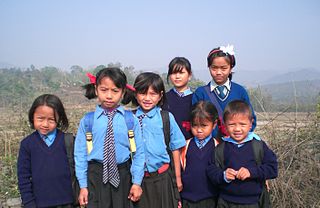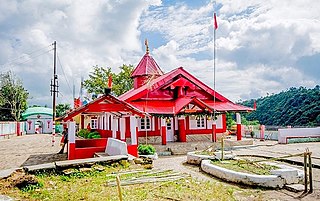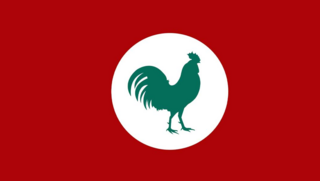
Meghalaya is a state in northeastern India. Meghalaya was formed on 21 January 1972 by carving out two districts from the state of Assam: (a) the United Khasi Hills and Jaintia Hills and (b) the Garo Hills. The population of Meghalaya as of 2014 is estimated to be 3,211,474. Meghalaya covers an area of approximately 22,430 square kilometres, with a length-to-breadth ratio of about 3:1.

Shillong is a hill station and the capital of Meghalaya, a state in northeastern India, which means "The Abode of Clouds". It is the headquarters of the East Khasi Hills district. Shillong is the 330th most populous city in India with a population of 143,229 according to the 2011 census. It is said that the rolling hills around the town reminded the British of Scotland. Hence, they would also refer to it as the "Scotland of the East".

The Khasi people are an ethnic group of Meghalaya in north-eastern India with a significant population in the bordering state of Assam, and in certain parts of Bangladesh. Khasi people form the majority of the population of the eastern part of Meghalaya, that is Khasi Hills, constituting 78.3% of the region's population, and is the state's largest community, with around 48% of the population of Meghalaya. They are among the few Austroasiatic-speaking peoples in South Asia. The Khasi tribe holds the distinction of being one of the few remaining matriarchal tribes of the world. Under the Constitution of India, the Khasis have been granted the status of Scheduled Tribe.

The Insurgency in Northeast India involves multiple armed separatist factions operating in some of India's northeastern states, which are connected to the rest of India by the Siliguri Corridor, a strip of land as narrow as 14.29 miles (23.00 km) wide.

The Khasi Hills is a low mountain formation on the Shillong Plateau in Meghalaya state of India. The Khasi Hills are part of the Garo-Khasi-Jaintia range and connects with the Purvanchal Range and larger Patkai Range further east. Khasi Hills, and the whole Garo-Khasi-Jaintia range, are in the Meghalaya subtropical forests ecoregion.
The Pnar, also known as Jaiñtia, are a sub-tribal group of the Khasi people in Meghalaya, India. The Pnar people are matrilineal. They speak the Pnar Language, which belongs to the Austro-Asiatic language family and is very similar to the Khasi language. The Pnar people are natives of West Jaintia Hills and East Jaintia Hills District of Meghalaya, India. They call themselves as "Ki Khun Hynñiew Trep". Their main festivals are Behdeinkhlam, Chad Sukra, Chad Pastieh and Laho Dance.
The Tribal people of Bangladesh refer to ethnic minorities in Chittagong Hill Tracts (southeastern), Sylhet Division (northeastern), Rajshahi Division (west), and Mymensingh Division (north-central) areas of the country. They are indigenous and the tribal races, total population of ethnic minorities in Bangladesh was estimated to be over 2 million in 2010. They are diverse ethnic communities including Tibeto-Burman, Austric and Dravidian people. Indigenous people of Bangladesh are the mainstream people originating from Dravidian, Indo-Aryan, Middle Eastern and Asiatic ancestry.

Khasi Hills Autonomous District Council (KHADC) is an autonomous district council in the state of Meghalaya in India. It covers West Khasi Hills district, Eastern West Khasi Hills district, East Khasi Hills district and Ri Bhoi district. It is one of the three autonomous district councils within Meghalaya, and one of twenty-five autonomous regions of India. Between its foundation on 27 June 1952 and 14 June 1973 it was known as the United Khasi-Jaintia Hills District Council. The total area of the Khasi Hills Autonomous District Council is 11,718 km2 having a population of 1,578,375 as of 2011.

Garo Hills Autonomous District Council (GHADC) is an autonomous district council in the state of Meghalaya in India. It is seated at Tura and covers East Garo Hills district, West Garo Hills district, South Garo Hills district, North Garo Hills district and South West Garo Hills district; is one of the three Autonomous District Councils within Meghalaya, and one of twenty-five autonomous regions of India. The total area of the Garo Hills Autonomous District Council is 10,102 sq km having a population of 1,394,362 as of 2011.

The Khasi and Jaintia Hills are a mountainous region that was mainly part of Assam and Meghalaya. This area is now part of the present Indian constitutive state of Meghalaya, which includes the present districts of East Jaintia Hills district, headquarter Khliehriat, West Jaintia Hills district, headquarter Jowai, East Khasi Hills district, headquarter Shillong, and West Khasi Hills district, headquarter Nongstoin.
Williamson Ampang Sangma, a Garo leader, former Chief Minister of Meghalaya, twenty-first state of India on 21 January 1972. He was also the first ever Governor of Mizoram among the Garos in 1989.
Evangelization of indigenous population to Christianity began in the 19th century under the British era. In the 1830s, American Baptist Foreign Missionary Society had become active in Northeast to evangelize indigenous tribes to Christianity. Later, they were offered to expand and reach into Sohra Meghalaya, but they lacked the resources to do so and declined. Welsh Presbyterian Mission took the offer and they began work at Sohra mission field. By the early 1900s, other Protestant denominations of Christianity were active in Meghalaya. The outbreak of World Wars forced the preachers to return home to Europe and America. It is during this period that Catholicism took root in Meghalaya and neighbouring region. Currently, Catholics, Presbyterians and Baptists are three most common Christian denominations found in Meghalaya.
Dkhar, is a term used by the Khasis to refer to non-Khasi people in Meghalaya. It is non derogatory but some perceived it as derogatory. For Khasis any non-tribal is a dkhar and they address them by that term. In real, the term is mostly used against affluent Bengali Hindu settlers from West Bengal or the Bengali Hindu refugees from erstwhile East Pakistan It is sometimes abbreviated to ′Khar and may also denote a Khasi clan with the same name.

The Insurgency in Meghalaya is a frozen armed conflict between India and a number of separatist rebel groups which was taking place in the state of Meghalaya. The Insurgency in Meghalaya is part of the wider Insurgency in Northeast India, and was fueled by demands of the Khasi, Synteng and Garo people for a separate state.

Multiple tribes in the state of Meghalaya in northeast India practise matrilineal descent. Often referred to as Khasi people and Garo people, among the Khasi people which is a term used as a blanket term for various subgroups in Meghalaya who have distinguishing languages, rites, ceremonies, and habits, but share an ethnic identity as Ki Hynniew Trep whereas the Garo people refers to the various groups of Achik people. The Khasi, Garo, and other subgroups have a proud heritage, including matrilineality, although it was reported in 2004 that they were losing some of their matrilineal traits. The tribes are said to belong to one of the "largest surviving matrilineal culture[s]" in the world.
This is a timeline of the Insurgency in Northeast India, an ongoing armed conflict between the separatist rebels and the Indian government.

The hill tribes of Northeast India are hill people, mostly classified as Scheduled Tribes (STs), who live in the Northeast India region. This region has the largest proportion of scheduled tribes in the country.

Hinduism is a minority religion in the Meghalaya state of India constituting 12% of the state's population. The Nartiang Durga Temple in Meghalaya is one of the 51 Shakti peethas on Earth and is considered by Hindus of Meghalaya as the permanent abode of Goddess Durga. Hinduism is a popular religion practice by Rabhas, Hajongs, Kochs, Rajbongshis, Mikirs, Bengalis, Nepalis, Biharis etc.

James Joy Mohan Nichols Roy was a Christian minister and politician from what is now the state of Meghalaya, India. Before the independence of India he agitated for autonomy of the tribal peoples of northeast India. After independence this was enshrined in the Sixth Schedule of the Constitution of India through his efforts.

The Seng Khasi movement, also known as the Khasi Students' Union, is a social and political movement that originated in the Khasi Hills region of the Indian state of Meghalaya. The movement was founded in the 1899 by a group of Khasi who were concerned about the loss of traditional Khasi culture and values due to the influence of British colonial rule and Christian missionaries.













